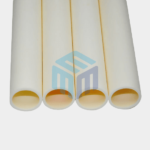Alumina crucibles are trusted for their high thermal resistance and chemical stability, making them a go-to choice for sintering, calcination, and high-temperature processing. However, a common and costly problem faced in laboratories and industrial furnaces is crucible cracking during sintering. This article explores the causes, science, and prevention methods behind this issue — helping engineers, researchers, and manufacturers protect their processes and materials.
Introduction: The Critical Role of Alumina Crucibles in High-Temperature Applications
Alumina (Al₂O₃) crucibles play a critical role in high-temperature applications across various industries due to their exceptional thermal stability, chemical inertness, and mechanical strength. Capable of withstanding extreme conditions without degrading or contaminating materials, these crucibles are essential in processes such as metal melting, ceramic sintering, and laboratory analysis. Their reliability and durability make them a preferred choice for environments demanding consistent performance under intense heat.
Understanding Sintering: A Quick Overview
Sintering is a thermal treatment process used to bond powder particles into a solid mass without melting them completely. It often involves:
- High temperatures (800–1800°C)
- Controlled heating rates
- Atmosphere control (air, argon, nitrogen)
Alumina crucibles are ideal containers for sintering, but improper usage or preparation can lead to failure.
Common Causes of Cracking in Alumina Crucibles
Understanding the factors that lead to cracking in alumina crucibles is essential for ensuring their longevity and performance. Identifying these causes helps prevent damage and maintain process efficiency in high-temperature applications.
Thermal Shock and Rapid Temperature Changes
One of the most common reasons for cracks is thermal shock — sudden changes in temperature that cause internal stress. If the crucible is rapidly inserted into a hot furnace or quenched, the material can fracture.
Improper Heating and Cooling Cycles
Abrupt ramp-up or ramp-down in furnace programs can lead to stress gradients in the crucible wall. A uniform heating profile is essential to minimize expansion mismatch.
Material Impurities and Manufacturing Defects
Crucibles made from low-grade alumina or with manufacturing inconsistencies (e.g., porosity, inclusions) are more prone to cracking during sintering due to internal weak points.
Mechanical Stress During Handling
Rough handling, clamping pressure, or forceful removal of sintered samples can cause microfractures that develop into full cracks during heating.
Moisture Absorption and Outgassing
Alumina is slightly porous. If stored in humid conditions, trapped moisture can vaporize and create pressure during sintering — leading to cracking or even explosion.
The Science Behind Alumina’s Thermal Behavior
Alumina has a low thermal expansion coefficient (~8 × 10⁻⁶ /K), which helps reduce stress under gradual heating. However:
- Localized heating or non-uniform temperature zones inside the furnace can cause uneven expansion.
- Alumina is also brittle, and while it resists deformation, it doesn’t absorb impact energy well — making cracks more likely from mechanical or thermal shock.
How to Prevent Alumina Crucible Cracking During Sintering
To prevent alumina crucible cracking during sintering, ensure gradual heating and cooling to minimize thermal shock. Avoid sudden temperature changes and ensure even heat distribution for improved durability and performance.
- Controlled Heating and Cooling Rates
Use programmable furnace profiles to maintain a steady temperature rise and fall — generally not exceeding 5°C/min unless specified.
- Proper Crucible Preheating
Before loading materials or exposing to peak temperatures, preheat crucibles slowly to drive off any residual moisture and minimize thermal shock.
- Storage and Handling Best Practices
Store in dry, temperature-controlled environments and avoid stacking or applying mechanical force. Always use tongs with padded or rounded ends to reduce surface stress.
- Choosing High-Purity Alumina Crucibles
Select crucibles with ≥99.8% purity, ideally from a trusted USA-based alumina crucibles supplier. High-purity grades have fewer internal flaws, better thermal resistance, and improved durability.
Read also: Types of Alumina Crucibles: A Complete Guide
Conclusion
Alumina ceramic crucibles are invaluable for high-temperature sintering, but understanding their limitations and care requirements is key to maximizing their performance and lifespan. If you’re experiencing frequent cracking, it’s time to revisit your handling, furnace programming, and crucible sourcing strategy.
Looking for high-purity alumina cylindrical crucibles supplier in the USA?
Contact us at info@mkubeenterprise.com or call +1-732-808-1999 for expert advice and product recommendations tailored to your application.
FAQs
Q: Can moisture cause alumina crucibles to crack?
Yes. Moisture absorbed into the crucible walls can turn into steam during sintering, causing internal pressure and cracks. Pre-drying is critical.
Q: Does crucible purity affect its resistance to cracking?
Absolutely. Higher purity crucibles are more thermally stable and structurally consistent, making them less prone to failure.
Q: Are alumina crucibles reusable after minor cracks?
It’s risky. Even small cracks can propagate under thermal stress. Reuse only if structurally stable and not used for critical applications.
Q: What temperature range is safe for alumina crucibles?
Alumina can handle up to 1700–1800°C safely, but exact limits depend on purity, wall thickness, and thermal cycling conditions.





